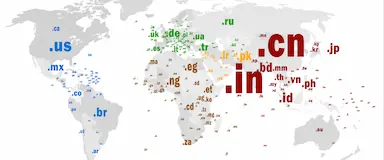With generic TLDs being oversaturated and marketed globally, country domains can help you reach a local audience and boost SEO.
From .com to .coffee: How New gTLDs Attract Niche Customers
Written by Steven White ·

You’re browsing the web one day, looking for websites of local coffee shops. Scrolling through search results in Google, you see the usual list of .com domain extensions. But there’s one that stands out – a website that has .coffee as its extension.
You’ve just seen a gTLD, and with these new extensions, you’re no longer limited to the traditional country-specific extensions that you’ve used in the past. Now, you have more options. And here, you’re going to discover what gTLDs are and why they’re such a great choice for your website.
What Are gTLDs?
gTLD stands for “Generic Top Level Domain.”
The term was defined in October 1984, bringing with it six domain extensions that would become the standard for the internet age:.com – far and away the most popular extension – as well as .gov, .edu, .mil, .org, and .net.
These are the extensions you’re most likely to see when you browse the web.
However, more recent developments have led to the introduction of a slew of new gTLDs, many of which speak to the specific nature of a website. The above .coffee example highlights how they’re used. Instead of having to settle for the generic .com, which tells the visitor little about what your website actually offers, you can now choose from thousands of site-specific gTLDs.
Why gTLDs Are Great for Attracting Niche Customers
The question you may ask is simple – why change a good thing?
After all, the original six gTLDs did a fine enough job of separating different categories of websites. But they were also recommended at a time when the web was in its infancy. Today, there are over 1.13 billion websites, over 200 million of which are still active, making the new breed of gTLDs vital for attracting niche customers.
Why?
Here are four key reasons you need a new gTLD.
Improved Search Engine Optimization (SEO)
At the most basic level, SEO is the act of trying to get your website to rank well in search engines based on the keywords somebody is likely to use to search for your product or service.
URLs play into your ranking.
A search engine will check your URL for instances of the keyword for which you want to rank and – combining what it sees with the content on your website – will rank it accordingly. If you have a gTLD that incorporates one of your keywords, such as .coffee for a coffee shop, you stand a better chance of ranking above your competitors in search engines.
Stronger Branding
Unique.
That’s the word that should be top of mind when you’re trying to create a brand. Unfortunately, there’s nothing unique about the .coms of this world, as their domain extensions don’t speak to the content of their websites.
A new gTLD does.
Again, .coffee is the perfect example. It’s a domain extension that is so rarely used, at least in comparison to .com, that it’s sure to stand out to anybody who comes across it.
Individualized Branding for Specific Products
Let’s take the branding benefit further.
You may operate a large ecommerce store that sells everything from clothing and jewelry to makeup. With new gTLDs, you can give each of those sections of your website a unique domain extension that helps you create a unique brand for every product line you offer.
It can even go further than that.
By 2016, over 600 companies had applied for brand-specific domain names, including BMW, CERN, and Google. Not only do these companies get to create URLs that contain their specific branding in the extension, but they’re also able to protect their brands by ensuring nobody else can snatch up those newly created gTLDs.
They’re Memorable to Visitors
Standard gTLDs have been around for as long as the internet.
They’re normal. Boring. Plus, as anybody who’s tried to register a domain name in the past might tell you, it’s often difficult to find one for your business because another company may have gotten to the associated domain name first.
With new gTLDs, you have the option to use any domain name you want while attaching it to a domain extension that sticks in the mind of a visitor.
Try the New Wave of gTLDs
You’re not restricted to the old gTLDs anymore. With the right domain registry service by your side, you can choose from thousands of extensions that do a far better job of communicating what your website is about than .com ever did.
Regdom is that registry service. Choose from over 1,000 gTLDs – with web redirection and email forwarding included – to take advantage of domain extensions that are better for branding and memorability.



